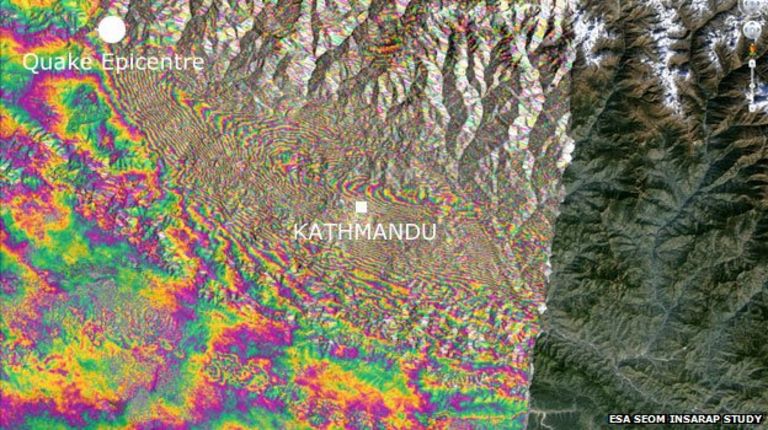Use of Sentinel Earth Observation Satellites for Coastal Needs
With an uncertain future that includes climate change, sea level rise and increasing coastal populations, being able to make informed policy decisions in coastal zones will be critical for ensuring the well-being of citizens, the environment and the sustainability of economic activities.
Earth observation (EO) can be used to efficiently and systematically provide the key information needed to make these decisions. However, getting access to the right EO information can be a complicated and costly business, limiting availability.
However, the launch in April 2014 of the first
Sentinel satellite from Europe's flagship EO program, Copernicus, represents a major advance in the availability of EO data, which has great potential to benefit numerous sectors involved in marine and coastal activities.
What is Copernicus?
Copernicus (previously Global Monitoring for Environment and Security-GMES) is an EU-led initiative in partnership with the European Space Agency (
ESA) that aims to aid decision making in a world facing increasing environmental and socioeconomic pressures. The program includes satellites with missions observing land, atmospheric and oceanographic parameters.
This space component comprises ESA's five families of dedicated
Sentinels (launched between 2014 and 2020) and contributing missions from other space agencies.
In common with the NASA/USGS (U. S. Geological Survey) Landsat missions,
access to Sentinel data is open, full and free to all.
This decision, very much appreciated by end-users,
is part of the strategy designed to ensure the long-term sustainability of Copernicus.
Reuse of data will generate new businesses and jobs, while providing consumers with more choice and value for their money.
In line with this idea, Copernicus is more than just its space component. It is solidly built upon
three other equally important pillars :
- in-situ (ground-based and airborne) measurements
- data harmonization and standardization
- and the provision of products and services to users.
These general services address six main thematic areas:
- land
- marine
- atmosphere
- emergency management
- security
- and climate change.
...
Indeed the opportunities for synergistic development of these generic services to provide value-added, user-specific downstream services in coastal zones are unlimited.
For example, a system to provide early warnings of marine toxic algal blooms for the aquaculture and fisheries industries that will help contribute to food security/safety is being developed by the ASIMUTH and AQUA-USERS projects.
Another example, already contributing to improvements in maritime safety and environmental protection, is radar satellite tracking of vessels and oil spills (CleanSeaNet and ARCOPOL), which enables the recognition of oil pollution, monitoring of accidental spills during emergencies and the identification of polluters.
A sector of growing interest, where Copernicus can potentially make an impact, is
risk management and
protection of coastal populations/assets.
Recent extreme weather events, such as the December 5, 2013 storm surge that affected
eastern England,
Hurricane Sandy in 2012 and
Hurricane Katrina in 2005, as well as the recent severe flooding events in the
southern U.K. and the
Danube, have firmly underlined the very real human and economic costs of coastal flooding.
Indeed, studies suggest that the future global economic impacts of
sea level rise and
changing climate will be substantial. Hence, assessing these risks and providing inno- vative solutions to
mitigate exposure is a very valuable endeavor.
In response, a number of international and national agencies have launched specific policy initiatives related to flood risks and coastal protection, including the United Nations Environment Program, World Bank, Federal Emergency Management Agency and the European Commission.
In Europe, projects such as Eurosion, Micore and Theseus, to name but a few, have contributed to flood-risk policy, as will ongoing projects such as Risc-Kit and Pearl.
However, none of these projects have been
specifically designed to harness the power of Copernicus- until now.
Foreshore Assessment using Space Technology, or
FAST (www.fast-space-project. eu), led by Mindert de Vries of the Dutch independent institute for applied research,
Deltares, has the ambitious aim of
developing downstream services using Copernicus to support cost-effective, nature-based shoreline protection against flooding and erosion.
...
Getting the Most out of CopernicusThis agile development concept is fundamental to all of the Copernicus services (generic and downstream), as stated in the mission brief by the European Parliament: "
Copernicus should be user-driven, thus requiring the continuous, effective involvement of users, particularly regarding the definition and validation of service requirements."
Hence, to a large degree it is also up to the user community to help define and shape the services they need. To this end,
FAST is in contact with a number of potential beneficiaries, ranging from small to medium enterprises (SMEs), such as consultancies and engineering firms, to environmental NGOs and governmental agencies.
The first consultations have yielded some interesting regional differences in requirements and expectations that are being introduced into the first demo version of the FAST services to be released in 2017.
Organizations, particularly SMEs, interested in learning more about the development of the FAST services are encouraged to make contact with the team via the project website.
One of the benefits to potential end-users from participating in service development is access to cutting-edge techniques that can provide advantages in terms of cost reductions and efficiency due to improvements in data gathering and decision making.
Overall, these benefits should be passed on to citizens as increased value for money and improved safety and wellbeing.
In the near future, growth in the availability of EO data is going to be exponential. Thus, the only potential limit on the vast capacity of Copernicus to stimulate knowledge-based services in coastal zones is the ingenuity of the global ocean community












 Les villes de Nice et de Menton vues dans l'infrarouge par le satellite Sentinel 2A (juin 2015). © Copernicus data (2015)/Esa
Les villes de Nice et de Menton vues dans l'infrarouge par le satellite Sentinel 2A (juin 2015). © Copernicus data (2015)/Esa
